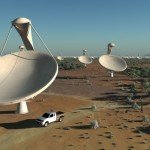Political lobbying may claw back some chance for New Zealand to participate in the $US2 billion Square Kilometre Array (SKA), the world’s biggest telescope array.
New Zealand joined Australia in a joint proposal for a trans-Tasman SKA with 3000 radio telescopes — many of them in the Western Australia desert and one or two in New Zealand — but they were apparently stymied at a key point by a rival bid to spread them across 10 African countries, including South Africa.

On March 9, Science journal Nature reported a scientific panel had narrowly recommended South Africa over Australia as the best site, though it noted the 20 nations funding the bid had not yet made their final decision. Nature said that the South African site had some compelling advantages: construction costs were lower, and it sat at a higher altitude. But the Australian site would be cheaper to insure, and was less likely to be affected by future development. The margin in favour of the winner was extremely narrow, it said in comments attributed to an un-named source.
Other commentators suggested South Africa’s bid was more attractive, not because it was technically superior to the Murchison site in Western Australia – where costs of powering the telescope and transferring the massive amounts of data collected would be lower – but because the selection team was likely to show a preference for involving a “developing nation”.
Since then, already-acrimonious lobbying from politicians on both sides has increased, and now the project’s leaders are considering whether to divide the spoils, Nature reports. SKA’s management board has asked a new scientific panel to determine whether the telescope, made up of 3000 15m-wide dish antennas and many more simpler antennas, could be divided between the two proposed sites.
John Womersley, head of the SKA board and chief executive of the UK Science and Technology Facilities Council, said that a compromise may be one way to resolve the battle. “I have heard astronomers that I respect say that such a solution is possible,” Womersley told Nature.
Professor Heino Falcke, a radio astronomer at Radboud University in Nijmegen, the Netherlands said the easiest solution would be to divide the project by placing the higher-frequency dishes on one continent and the lower-frequency antennas on the other.
Doing so would almost certainly raise the SKA’s price tag, because computing centres and power would be needed in both remote locations, said Frofessor Albert Zijlstra, director of the Jodrell Bank Centre for Astrophysics in Manchester, UK.
Splitting the antennas by frequency would avoid the need for a high-throughput data link connecting the two sites, but Prof Zijlstra said he could see little scientific advantage to splitting the project, aside from a few extra hours of observation time gained from having the telescope’s two parts separated by such a vast distance. Prof Falcke agreed. “It’s a question of politics,” he said.
The panel is expected to deliver its results by mid-May, when the SKA board will meet again to discuss the site. Construction is likely to start in 2016 and expected to take six years to complete.